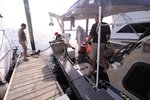Those hunting for remnants of the HMS Gaspee that colonists set afire more than 250 years ago off Namquid Point (now Gaspee Point) have located multiple targets as of Tuesday, but so far, only one …
This item is available in full to subscribers.
We have recently launched a new and improved website. To continue reading, you will need to either log into your subscriber account, or purchase a new subscription.
If you are a current print subscriber, you can set up a free website account by clicking here.
Otherwise, click here to view your options for subscribing.
Please log in to continue |
|



Those hunting for remnants of the HMS Gaspee that colonists set afire more than 250 years ago off Namquid Point (now Gaspee Point) have located multiple targets as of Tuesday, but so far, only one shows promise of being more an assortment of modern trash.
“We are still receiving remote sensing data, and so far there are 198 targets from the side scan sonar, most of which are modern trash (tires, car engine blocks, etc.). Only one of these targets looks anything like what we would expect to see of a vessel's remains and RIMAP dive teams have spent three days carefully investigating the bottom at that location. We will need at least one more day to complete that non-disturbance study, but so far nothing indicates the presence of a ship. So if it is at that location, it is completely buried,” Dr. Kathy Abbass, principal investigator with the Rhode Island Marine Archeology writes in an email Tuesday.
It hasn’t been an easy search.
“If it’s black silt and vegetation, you don’t see much,” diver Peter Nulton said Sunday as he and the crew of the research vessel readied to leave Pettis Boatyard in Warwick. Fortunately, not all below the water is muddy. There’s also a lot of sand and in those areas the visibility is better. But that can be affected by the tide and the current.
“There’s a lot of crabs,” said Nulton. He started listing them -- including blue crabs, horseshoe crabs, sider crabs and “no end of hermit crabs.”
Abbass is following up on more than targets off shore. She related Sunday a story from a local that he recalled seeing the remains of a ship closer to shore following a hurricane in the 1950s. Apparently it was “right on shore.”
“We’re not going to turn down anything…this is for science and when you get a call you take it seriously,” she said. Abbass pointed to the value of local knowledge.
“We take the public seriously,” she said.
On Tuesday, the water search was suspended as volunteers directed attention to the shallows and point. Thankfully, Mother Nature cooperated with lower humidity and temperatures.
As for the potential off-shore target, Abbass thought it could be the site examined 20 years ago by marine archeologist Steve Schock. She described it as an area that has been disturbed.
This time, however, the search has been aided by the latest technology.
“The sub-bottom profiler data will take longer to digest since the lanes for its survey are narrower than those for side scan. That means it takes longer to survey the same area with sub-bottom than it does for side scan, and in order to be thorough, we added an extra field day for that survey. This was possible only through the generosity of RIMAP's financial donors, and especially Cranston's Syqwest Inc. that provided the stratabox equipment and operator,” Abbass writes.
Those backing the project with donations and their time volunteering went into the search hopeful of finding something, but knowing little more could be learned than knowing they had performed a thorough search.
While the site investigation will come to a close in less than a week, the hunt for the Gaspee will go on.
“It is clear that digesting all of these data will continue long past the fieldwork phase, but so far we have seen is a lot of what is NOT the Gaspee. However, with the remote sensing and weather delays we are only half-way through the planned fieldwork, so we may get lucky by the time the work at Gaspee Point is done. Then we will announce our findings and the research process will continue data analysis at RIMAP's lab in Bristol. Only then may the fieldwork results be confirmed,” Abbass said.
Comments
No comments on this item Please log in to comment by clicking here